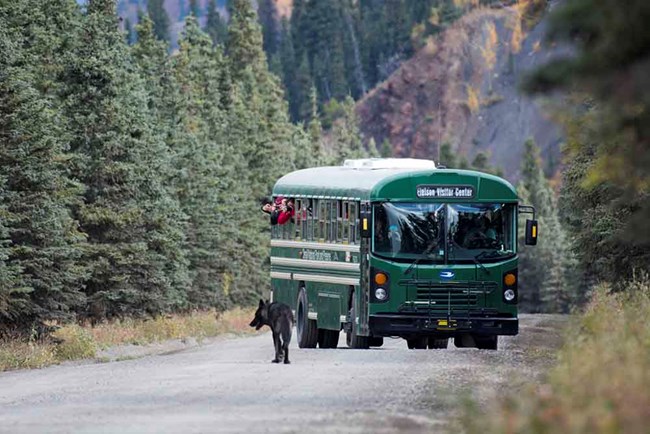Last updated: September 6, 2024
Article
What determines the likelihood of seeing wolves in Denali?

Wildlife viewing within protected areas is an increasingly popular recreational activity and many people come to Denali National Park and Preserve in Alaska hoping to see iconic wildlife species such as moose, caribou, grizzly bear, and wolves. However, there have been few studies designed to determine which factors play a role in wildlife sighting rates and the potential for management actions to affect people’s opportunity to see wildlife. This study used data from almost 3,000 trips into the park and the location data from GPS-collared wolves to investigate how factors such as wolf pack size, den location, vegetation, and wolf harvest outside of the park impacted wolf proximity to the road and wolf sightings along the road.
As expected, we found that open areas, larger pack sizes, and den site proximity to the road increased the probability of sightings. We also found that harvest outside the park affected sightings and that during the harvest closure, wolf sightings increased with den site proximity to the road, but when harvest was allowed, den proximity had no effect on sightings. While this may suggest that human-related risk can alter the behavior of wolves, further research would be needed to fully explore a link between harvests and wolf behavior.
Determinants of Gray Wolf (Canis lupus) Sightings in Denali National Park
Abstract
Wildlife viewing within protected areas is an increasingly popular recreational activity. Management agencies are often tasked with providing these opportunities, yet quantitative analyses of factors influencing wildlife sightings are lacking. We analyzed locations of GPS-collared wolves and wolf sightings from 2,945 trips in Denali National Park and Preserve, Alaska, USA, to provide a mechanistic understanding of how viewing opportunities are influenced by attributes of wolves and physical, biological, and harvest characteristics. We found that the presence of masking vegetation, den site proximity to the road, pack size, and presence of a wolf harvest closure adjacent to the park affected wolf sightings, and the influence of den proximity on sightings depended on harvest management. Wolf sightings increased with den site proximity to the road in years with a harvest closure adjacent to the park but not in the absence of the closure. The effect of the harvest closure on sightings was similar in magnitude to an increase in pack size by two wolves or a more than a two-fold decrease in masking vegetation. These findings were consistent across a 10-fold change in spatial resolution. Quantitative analysis of the factors influencing wildlife sightings provides valuable insight for agencies tasked with managing viewing opportunities.
Borg, B. L., S. M. Arthur, J. A. Falke, and L. R. Prugh. 2021. Determinants of gray wolf (Canis lupus) sightings in Denali National Park. Arctic 74(1): 51-66. https://doi.org/10.14430/arctic72208
